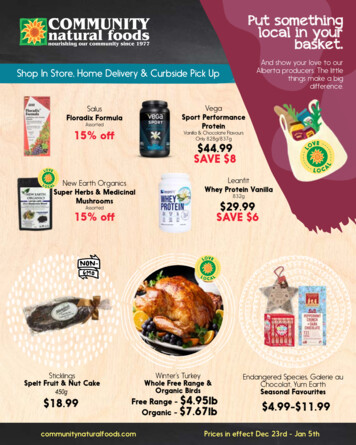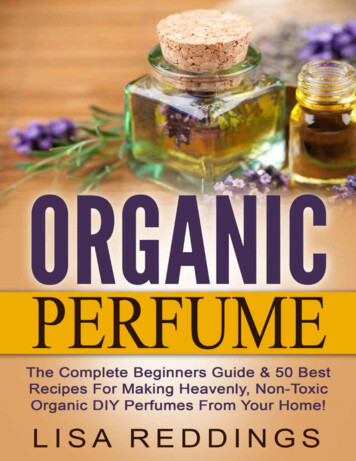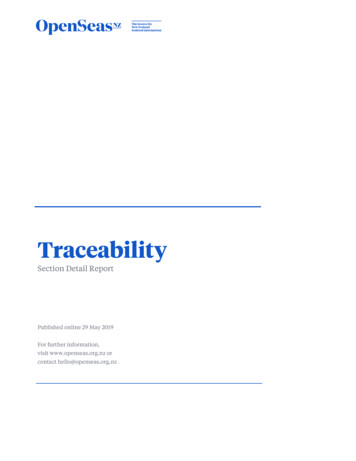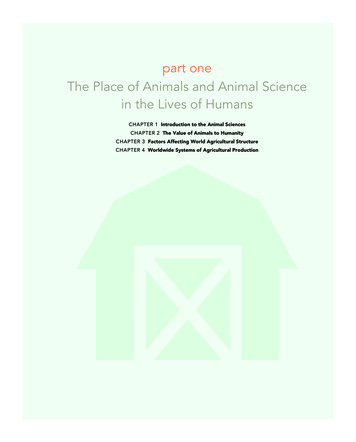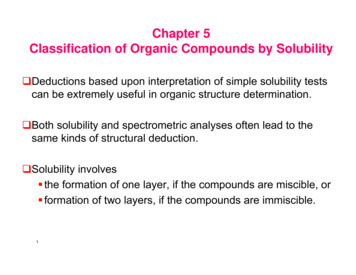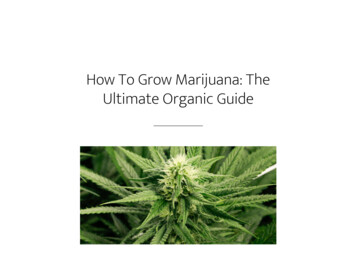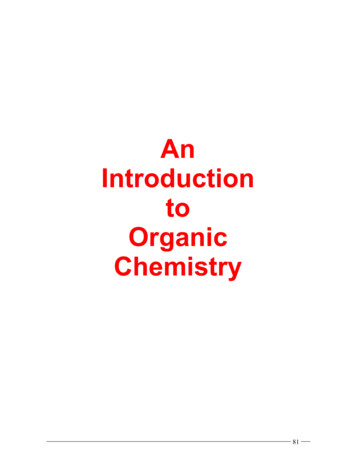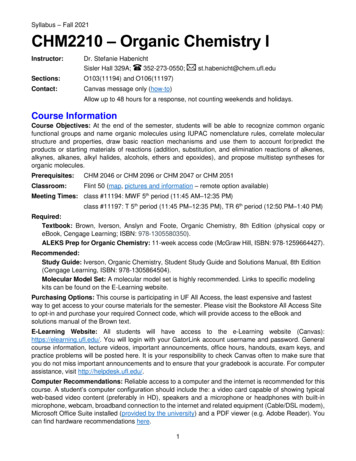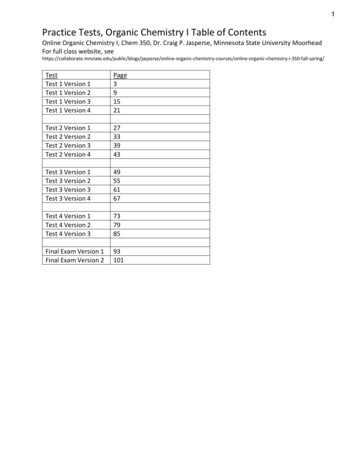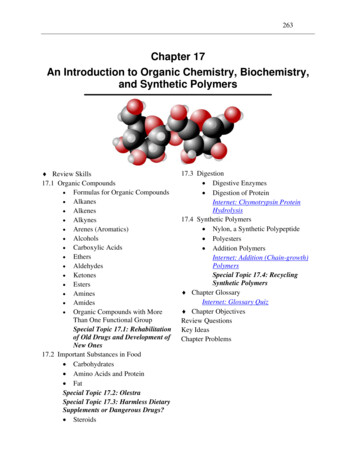
Transcription
Archived at http://orgprints.org/4814Animalbreedingin organic farmingDiscussion paperWytze J. Nauta, Ton Baars,Ab F. Groen, Roel F. Veerkamp, Dirk RoepOctober, 2001
Louis Bolk Institute, 2001Hoofdstraat 24, 3972 LA, DriebergenThis discussion paper is published by Louis Bolk Institute, Hoofdstraat 24, 3872 LA Driebergen, theNetherlands. Copies can be ordered from Louis Bolk Institute for 15 per copy, including shipping costs.Please cite publication number LV 45 in your order.2
3
ForewordThis discussion paper was written for the vision building project "Organic breeding, a long way to go"which is carried out the Netherlands. In this project, we aim to make succinct choices with regard toanimal breeding in organic agriculture, as well as an action plan to realise an appropriate system ofbreeding. The purpose of this discussion paper is to facilitate a broad discussion with organic farmers andother stakeholders, such as breeding companies, interest groups and policy-makers.The vision project builds on Klarita Varenkamp's pioneering work for Louis Bolk Institute, which culminatedin a biodynamic vision on breeding (Varenkamp, 1997). The discussion paper before you is the result of anextensive study of the literature as well as discussions and interviews with organic farmers and breedingorganisations in the Netherlands. In addition, scientists from various disciplines with roots in bothconventional and organic agriculture contributed their specific expertise.The project team is made up of Wytze Nauta MSc. (breeding and livestock scientist, Louis Bolk Institute),Dr. Ton Baars (Head of Livestock Section, Louis Bolk Institute), Dr. Ab Groen (senior lecturer, Breeding andGenetics Group, Wageningen University), Rudolf van Broekhuizen MSc. and Dr. Dirk Roep (both lecturerswith the Rural Sociology Section, Wageningen University) and Dr. Roel Veerkamp (breeding scientist, IDLelystad).The project team has received valuable support from the members of the advisory committee: Prof Dr PimBrascamp (Breeding and Genetics Group, Wageningen University), Dr Hans Schiere (InternationalAgricultural Centre, Wageningen), Prof Dr Elsbeth Noordhuizen-Stassen (Special Chair for Man-AnimalRelationships, Utrecht University), Dirk Endendijk (FH breeder, chair of the Dutch FH Association andfarmer), Age Opdam (breeder and farmer) and Dr Henk Verhoog (ethicist, Louis Bolk Institute).The vision building project "Organic breeding, a long way to go" is made possible by a grant from theMinistry of Agriculture, Nature Management and Fisheries.Wytze NautaProject head4
5
SummaryOrganic agriculture is growing fast. Between 1993 and 1998, the total area under organic agriculture inEurope increased by almost 30%. It currently covers about 3.8 million hectares, or 3% of the totalagricultural area. In the Netherlands, this is 1.4%. The sector's current and predicted growth can beattributed to the high public appeal of organic farming's principles. There is a risk, however, that for lack ofavailable alternatives the sector will turn to more conventional methods in order to achieve the growththat the market demands, thus compromising its identity. In the light of this, it is vital that the sectorcontinues to invest in its own qualitative development. There is currently much debate about the courseof the organic agri-ecological system and the type of breeding that would best fit this system.It is uncertain whether animals which have been bred for conventional production are capable ofoptimum performance in organic conditions. In conventional agriculture there is a movement towardsmaximum control of production conditions in order to optimise animals' yield in intensive productionsystems. By contrast, organic agriculture is based on natural processes and closed cycles, and takes intoaccount the underlying connections between production factors. Following organic ideology, productioncapacity should be curtailed by acting in accordance with guiding principles such as naturalness, animalwelfare, efficient use of fossil fuels in the farm cycle, and agri-biodiversity (IFOAM, 1994). Organicproduction should be tied to the land, with farms preferably being self-sufficient mixed farms with closedcycles.An additional point of concern are the reproduction techniques used in conventional breeding. Artificialinsemination (AI) and embryo transfer (ET) are commonplace in conventional animal breeding. But thesetechniques are 'artificial' and they deprive animals of natural mating behaviour and negatively affect theanimals' welfare and integrity. By bringing in animals from conventional agriculture, organic farmers areindirectly making use of these techniques. These and other concerns have led to the project 'Organicbreeding: a long way to go', which aims to lay down clear visions and an action plan for an organicbreeding system.Technological developments such as quantitative genetics, and reproduction technologies have helpedtransform animal breeding from a small-scale farm or regional activity into a global system. Themetamorphosis of the dairy sector in the 1980s is also largely due to the introduction in of the HolsteinFriesian breed. In fifty years' time, milk yields rose incredibly, for example in the Netherlands with 57% toover 8000 kg milk per lactation in 1999. Animal breeding, whether of cattle, pigs or poultry, is currentlydominated by multi-national companies. Breeding programmes are more and more carried out on anucleus basis. In pigs and poultry purebred lines are used to produce crossbreeds for the market. Thesecrossbreeds are geared to production: in a conventional system, hybrid pork pigs grow an average of 840 gper day, while laying hens can produce a laying rate up to 95%.For years, the organic sector was very small and mostly made up of biodynamic farms. The developmenttowards a sector which encompasses various kinds of ecological production began in the 1980s and thesector has continued to grow steadily ever since. The principles of organic agriculture are laid down by theInternational Federation of Organic Agriculture Movements (IFOAM) and in European Commission'sregulation 2092/91. The guiding principle which lies at the root of these organic regulations is thecoherence between natural processes. This principle explains the importance of maintaining soil fertilityand a preventive approach to crop health and animal health in organic farming. It is also the reason thatindependence, in the form of closed cycles, rates so highly in the organic sector.As in conventional farming, different approaches to the system are developing in organic farming. Thereare farms involved in large-scale production of ingredients for industrial processing. The extra return onorganic products is their motive for complying with the organic criteria laid down by law. Next to this fastgrowing pragmatic approach is a large group of farmers who are motivated by the wish to realise a6
responsible agri-ecological system, i.e. production tied to the land at farm level or regional level, closedcycles and minimum inputs. A third, smaller group is primarily concerned with the integrity of theproduction system and of the animals within the system. Their principles are an explicit consideration intheir manner of farming. Our interviews with organic farmers reveal that each stream has a need foranimals which are optimally adapted to the specific type of farm management.The wish for a breeding system which meets the needs of organic agriculture requires discussion of severalaspects. First, there are several ethical objections to modern reproduction technology. AI is included in ourdiscussion of this subject, as some of the arguments against ET also apply to AI. An important objection toAI and ET is that it lifts reproduction out of its natural context. There is no contact between the animalsduring the act of reproduction. Semen, ovaries and/or embryos are subjected to large fluctuations intemperature. Research has shown a link between ET and an increase in embryo mortality and birthproblems. In vitro culture techniques followed by ET increase the chance of deformities and postnatalmortality in calves. Moreover, these techniques are a stepping stone to sex determination of semen andembryos, cloning and the genetically alteration of animals. All this forces the question whether organicagriculture can accept continued use of a breeding system which integrates such techniques. If theorganic sector wishes to restrict its use of these techniques, however, it must realise the impact of thatchoice on the accuracy and intensity of selection, two important factors in realising genetic progress.The second category of concerns relates to estimated breeding value. Animals can be compared andselected at a young age on the basis of ancestry. This might lead to a preference in the selection processfor early maturing animals. Also quantitative genetics take a reductionist view, as it reduces an animal toa number of quantitative traits, in contrast with the more holistic view of animals in organic farming.Some organic farmers deliberately select on the basis on an animal's own lifetime production in theassumption that this ensures the selection of all the necessary traits needed for production. Conventionalbreeding, too, is starting to weigh functional characteristics such as fertility and lifespan more strongly inestimated breeding values. Including such functional traits also leads towards selection of lifetimeproduction, is the meaning of several breeding organisations.The third category of concerns relates to genotype by environment (GxE) interaction. Are the traitsselected in conventional breeding still relevant to and comparable in organic agriculture? As yet, there hasbeen no scientific research into differences in GxE interactions between conventional and organicagriculture, but the hypothesis is that these differences do exist, especially with respect to functionalcharacteristics and when differences between the two types of production are greater.The primary traits and goals of breeding depend to a large extent on developments in and approaches toorganic agriculture and the hypothesized GxE interaction. Farms with overlaps with conventional farmingwill probably make more use of conventional breeding than more idealistic, principled farmers. The greaterthe differences between systems, the less likely desirable characteristics are to be the same.Finally, breeding also has a socio-economic aspect. Breeding is a hobby of many farmers, specially in dairyfarming, that also lends one a certain status among fellow farmers. Breeding for organic agriculturesupports the individual, farm-specific character of breeding and is less dependent on conventionalinstitutional structures. In this way, organic agriculture can ensure more diversity within breeds andencourage the use of local breeds.At the end of this report, we present a number of possible future scenarios based on facts anddevelopments in the field of breeding and in organic agriculture. The scenarios are presented in asequence from most pragmatic to most congruent with organic ideals. The scenarios are intended to helpparticipants in the discussion on breeding focus on the different bottlenecks and possibilities. The two endsof the scale are made up by a worldwide breeding system on the basis of quantitative genetics on the oneend, and regional breeding based farm-specific breeding on the other.The principles of more organic based breeding strategies for the different animal species can be the same.However, current practices in breeding cattle, pig and poultry are different. Cattle breeding is still an7
open system and organic farmers can still choose their own breeds and strategies. Current pig and poultrybreeding is more or less the exclusive domain of international breeding companies providing farmers withhybrid animals. Therefore, realising more organic based breeding strategies for these species will present amajor challenge. Nevertheless, there are possibilities which can be explored.8
Table of ments in animal breeding2.1. Definitions of selective animal breeding2.2. Selective breeding strategies2.3. How selective breeding started2.4. Development of quantitative breeding2.5. Developments in dairy breeding2.5.1. The structure of the dairy breeding sector2.5.2. The impact of reproduction technologies2.5.3. Indexes and genetic trends2.5.4. Organic dairy breeding today in the Netherlands2.6. Alternative breeding strategies2.6.1. Breeding based on lifetime production2.6.2. Kin breeding and foundation breeding2.6.3. The choice for another breed2.6.4. The triple-A system2.7. Developments in poultry breeding2.7.1. Breeding and genetic trends in the 20th century2.7.2. Organic poultry production and breeds used in the Netherlands2.8. Developments in pig breeding2.8.1. Breeding and genetic trends in the 20th century2.8.2. The structure of the pig breeding sector2.8.3. Breeding in the Dutch organic pig 3.Organic farming and its development3.1. Brief history of organic agriculture3.2. Basic principles of organic agriculture: what is organic farming?3.3. The organic sector in figures3.4. Future perspectives3.5. The role of animals in organic agriculture, general principles and characteristics3.5.1. Efficiency in the system and production in keeping with their nature3.5.2. Animal integrity and welfare3.5.3. Resistance to disease3.5.4. Genetic modification424243444651515252524.Points for discussion4.1. Reproduction technologies4.2. Quantitative genetics4.3. Genotype-environment interaction4.4. Traits and breeding goals4.5. Social- economic aspects and diversity4.6. Generalisation versus differentiation4.7. Animal welfare and integrity54545758596061615.Possible scenarios for breeding in organic agriculture5.1. Scenarios for dairy breeding5.1.1. The use of conventional breeding schemes5.1.2. Conventional breeding without ET5.1.3. Conventional breeding adapted to organic agriculture5.1.4. Breeding based on an organic basis and organic principles5.1.5. Regional breeding5.1.6. Farm-specific (on-farm) breeding5.2. Breeds and hybrids5.3. Considerations in scenarios for pig breeding5.4. Considerations in scenarios for poultry breeding6262626363646465656767References69
Apendixes7410
1. IntroductionThe scale of organic agriculture has increased rapidly in the last ten years. People nowadays are moreconcerned about their own health (Pollan, 2001) and about the health of our environment and our natureareas; concerns which have resulted in a greater demand for organic food (De Wit and Van Amersfoort,2000). There are now more than 129,000 organic farms in Europe (SÖL, 2001), which together cultivate3% of the total area under agriculture. In the Netherlands this is 1.4% and 42% of these farms areinvolved in livestock production. Dairy farms have the largest share in organic livestock production in theNetherlands, although the numbers of pork and poultry producers are growing.The regulations and standards governing organic agriculture have evolved from regulations for manureapplication and crop growing to now include standards for animal production as well (EU, 2000). Animportant aspect of the EU's regulation for organic livestock production is the origin of the animals.Officially, brought in animals from a conventional source may not exceed the yearly maximum of 10% ofall animals of the same species on a farm (IFOAM, 2000). The practical interpretation of this rule is thatthe animals concerned should not be purchased directly from a conventional farm or breeding company.When conventional animals are kept under organic circumstances for a certain period of time, they areconsidered organic. In this way poultry farms can restock with conventional animals which are rearedorganically. The regulations only address the bringing in of conventional animals as stocking material.Through the use of AI, however, organic dairy and pig farmers are bringing in up to 100% conventionalstock. The concerns, however, are more in the field of the genetic origin of the animals, while all theanimals are selected for the conventional farming systems.It is the genetic background and the technologies used in modern conventional breeding which raisequestions with farmers, breeders and consumers. Until now, there has been very little in the way ofstructural thought towards development of a common position as to what type of breeding would bedesired, which breeding methods are needed, which breeding goals suit organic and related aspects suchas diversity, animal welfare and naturalness of breeding.Concerns about the use of conventional breeding stock fall into three main categories: ethical concerns,agri-ecological system related concerns and reservations regarding technical aspects of breeding.From an ethical viewpoint, there is the question to what extent animals may be used for productionwithout regard for their welfare and integrity. IFOAM's guidelines for animals in organic productionsystems are clear (see appendix 1: IFOAM Animal Production). Animals may not be produced using embryotransfer techniques (ET). Animals must be able to adapt to local conditions, thus ensuring diversity.Animals must be able to function in a system which is defined by organic principles such as naturalnessand animal welfare. And finally, animals may not be mutilated (IFOAM, 2000).In particular, modern reproductive technologies and ever more advanced selection are putting theintegrity and welfare of animals at stake. Unless certain technologies (ET) are banned in organic farming,the indirect use of these techniques is unavoidable as they are commonly used in conventional breeding,especially dairy breeding. New technologies are being developed like marker assisted selection (MAS),sexing of sperm and maybe genetic engineering. These techniques make the use of conventional breedingstock in organic farming questionable or even controversial.Another ethical concern is the lack of variation in breeds. Most dairy farmers in the Netherlands haveHolstein Friesian cows (Elbers and Nauta, 2000), while pig and poultry producers are dependent on a fewconventional hybrids or brands (De Wit, 2001; Bestman, 2000). In other western countries practices areexpected to be the same. The low variation can be dangerous for the maintenance of the species.Animal welfare is at stake if animals selected for conventional conditions can not cope with an organicsituation. These animals have a very high genetic predisposition for production and therefore need highquality feed and concentrates. These are not always provided on organic farms. This can lead to healthand fertility problems and more intensive veterinary management. Furthermore, conventional animals11
sometimes lack characteristics which are desirable in organic systems. For example, modern pig breedshave very little body hair and a short snout, which makes them less capable of coping with sun and heatin an outside run. They also have relatively little body fat to protect them from the cold (Van Putten,2000). Holstein cows have long, dangerously formed horns which increase butting injuries (Baars andBrands, 2000; Waiblinger et al., 2000). In hens, negative pecking behaviour and cannibalism occur(Bestman, 2001; Hierden, 1997; Kjaer and Sorensen, 1997). In conventional agriculture, animals aremutilated to prevent the onset of such undesirable behaviour or characteristics. In principle, mutilationsare banned in organic farming as it compromises animals' welfare and integrity.The second category of concerns stems from the fundamental differences between the agri-ecologicalsystem upheld by organic agriculture, in which ideally animals should be adapted for optimumperformance at a specific farm, and the conventional system, which is adapted to meet the needs of highyielding animals and leads to standardizing of farming systems and the loss of diversity . Should organicagriculture adopt, to some extent, conventional practices ? Some change is already being seen in theapproach to organic farming. Farms are scaling up and specialising, which necessitates large inputs ofbedding and feedstuffs. Other farms are developing more as an agri-ecological system with closed cyclesand minimum inputs (Verhoog et al., 2001). Therefore, the type of animal or traits needed in organicfarming depends on the development of the organic sector in general. A more rational, specialised andindustrialised approach will certainly do well with conventional breeding stock. But a more 'true organic'approach will certainly challenge today's breeding strategies.With respect to aspects of breeding, there are concerns about diversity, GxE interactions and the impactof reproduction and selection techniques. The high yields being realised in conventional farming appear tobe exclusive to the breeds and crosses provided by conventional breeding. As yet, there is no scientificevidence of differences in GxE interactions between conventional and organic agriculture, but this doesnot preclude the possibility that they might play a role in the expression of conventional genotypes in adeviating, organic, environment. The widespread use of reproduction technologies may lead to the loss ofnatural fertility. A ban on embryo transfer (ET) and related technologies might have a strong effect on theexisting selection systems and genetic progress. A complete ban would diminish the number of breedingbulls which can be used by organic farmers.The selection techniques themselves are questionable with respect to efficiency, speed and reductionism.For example, the speed at which high accurate estimated breeding values of young animals are availablemay lead to the selection of early maturing animals. Finally, from an organic and holistic point of view it isquestionable if an animal can be selected on the basis of a small number of characteristics.Adapting the animal to the environment, or the environment to the animalBreeding was an important part of the enormous technological push made by conventional agriculture in the last forty years (Vander Ploeg, 1999; Roep, 2000). Production has become highly specialised and increased tenfold, per animal as well as per hectare.Production conditions have largely been standardised (housing, feed). Production levels have reached an economic optimumthanks to synthetic chemical fertiliser, pesticides and cheap imports of feed ingredients. All this can be put down as adapting theenvironment to the highly productive animals.By contrast, the roots of organic production lie in natural processes and closed cycles, and taking into account the underlyingconnections between production factors. Following organic ideology, production capacity should be curtailed by acting in12
accordance with guiding principles such as naturalness, animal welfare, efficient use of fossil fuels in the farm cycle, and agribiodiversity (IFOAM, 1994). In the early days of organic agriculture, every effort was made to ensure that organic production wastied to the land, that farms were self-sufficient mixed farms with closed cycles. Acting in accordance with these guiding principles,each farm selected its own animals for breeding towards the ultimate goal of animals which were optimally adapted to thespecific conditions of the farm.The growing gapAs organic agriculture grew in the 1980s and 1990s, so did conventional breeding: embryo transfer became widely available andbreeding strategies combined with new housing systems produced impressively high-yielding animals. This raised concerns inorganic circles about the genetic suitability of conventionally bred animals for organic production. In the late 1980s, there weresmall initiatives by organic dairy producers to set up organic breeding based on line breeding and on-farm breeding (Baars,1990b), but until now this has not resulted in a comprehensive organic approach to breeding. With organic agriculture nowenjoying explosive growth and great popularity with the public and policymakers, it is vital that the sector works on furtherqualitative development. The fast pace of technical developments in conventional agriculture underscore this urgency. Geneticallymodified animals are not yet being used, but cloning, sexing and marker selection are slowing being incorporated in breeding(Brascamp, 1992; Rotschild, 1998; Seidel, 1992).In addition to ethical and technical concerns is the question of image: can organic agriculture afford tocontinue to use conventional breeding? Some consumers demand 'real organic', products which theyperceive as being truly natural and made with respect for animals (De Wit and Van Amersfoort, 2000a).Organic agriculture must also earn its licence to produce. IFOAM and European standards for organicproducts state that organic livestock production should use 'organic' stock wherever possible (EU, 2000;IFOAM, 2000). The new food safety policies of traceability also demands closed cycles in which productsand their constituents can be followed every step in the chain from farm to fork (Wijffels et al., 2001).The sum of it is that many organic farmers in the Netherlands are unhappy about their current breedingchoices (Nauta, 2001). In other countries this was not yet researched but feelings are probably the same.The gap between conventional and organic agriculture is becoming wider and wider. Yet developmentsare taking place on both sides of the gap which might be significant in the discussion on breeding (seeboxes) and should therefore not be overlooked.Changes in organic and conventional agriculturePublic opinion is forcing conventional agriculture to rethink its strategy with respect to the environment and animal health andwelfare, aspects which are also of primary importance in organic agriculture. In this respect, conventional agriculture is starting toresemble organic. A differentiation is developing in conventional agriculture from large-scale factory farming at one end to multifunctional agriculture, in which farming contributes to rural development in a variety of ways, at the other end (Frouws and VanBroekhuizen, 2000). It is this multi-functional form of agriculture which has considerable overlap with organic agriculture.A similar process of differentiation is taking place in organic agriculture. New styles and streams are emerging. Verhoog et al.(2001b) identify at least three categories based on a producer's view of naturalness as the primary shaping force of organic farmmanagement. These views, broadly speaking, relate to the use of chemicals, the agri-ecological system or integrity. Regardless ofwhether they are organic or conventional, farmers' breeding wishes and needs are strongly determined by their view on farmingand management (Groen et al., 1993; Verhoog et al., 2001b).GoalThe vision project 'Organic breeding' was born of farmers' uncertainties about breeding and the manyconcerns about breeding in organic agriculture in general. The objectives of the project are:1. To lay down visions on the possibilities and limitations of a breeding system which respects theprinciples of organic agriculture and the diversity of viewpoints within the organic sector.2. To provide a discussion report to direct and support discussions on breeding.3. To develop an action plan for an organic breeding system supported by the organic sector.13
The publication of this report rounds off the first part of this project and paves the way for a series ofdiscussions on breeding, ethical implications and the course of the agri-ecological organic system.MethodLouis Bolk Institute's method of conducting research is characterised by a participatory approach: itsprojects in organic agriculture are carried out in cooperation with farmers who are considered pioneers intheir field (Baars and De Vries, 1999). This discussion paper is based on interviews with primary producersand other stakeholders, a study of the literature and the pools of knowledge within Louis Bolk Instituteand Wageningen University and Research Centre (Rural Sociology Group, Animal Breeding and GeneticsGroup, and ID-Lelystad). The topics for discussion presented in this report are the result of an analysis inthe Netherlands of the current situation and developments in breeding in the light of the principles andmethods prevailing in organic agriculture. The report is most strongly focused on dairy cattle, as dairyproduction by cows is the largest livestock sector in the Netherlands. Pig and poultry production and thedifficulties and opportunities in these sectors are only briefly discussed. Although each sector has its ownspecific problems, the same general approach might serve for all these sectors (see chapter 5).The discussion paper is intended as a basis for the discussion and evaluation of ideas on breeding inorganic agriculture, both in the Netherlands and in other countries. To this end, Louis Bolk Institute haspublished a Dutch and English versions of the discussion paper. Discussions will take place with organicfarmers in study groups and workshops. The outcome of these discussions will be presented in a finalreport, which will also contain an action plan for the development of an organic breeding system.A guide to reading this reportThe report is mainly based on Dutch research and circumstances, but many aspects are also relevant toother western countries. Chapters 2 and 3 give detailed information on breeding and organic agriculture,respectively, and are included for reference and as a crash course for those who are not well acquaintedwith one or both fields. The points at which conventional breeding and organic agriculture grate aredescribed in chapter 4. These difficulties concern reproduction techniques, selection techniques, genotype environment interactions, socio-econo
transform animal breeding from a small-scale farm or regional activity into a global system. The metamorphosis of the dairy sector in the 1980s is also largely due to the introduction in of the Holstein Friesian breed. In fifty years' time, milk yields rose i
